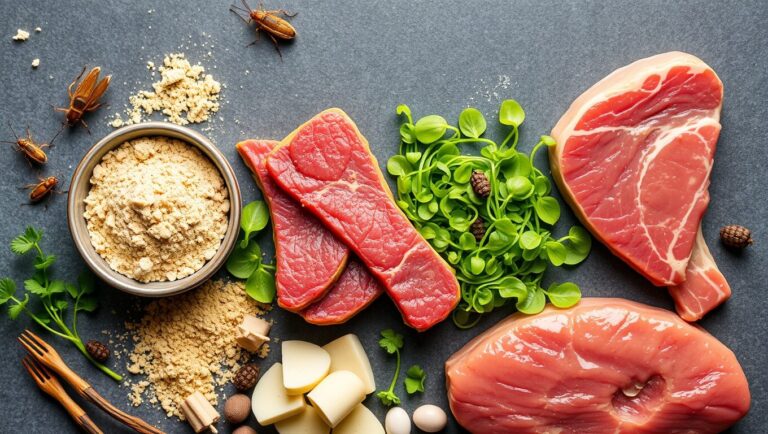
In the Western world, when you think of protein, more often than not chicken, pork, mutton, or beef comes to mind. These are staple foods in so many British dishes, from shepherd’s pie to steak and chips. Heck, even a protein shake possibly comes to mind.
But have you ever thought about incorporating other forms of protein into your diet? Let’s say, algae, or even lab-grown meat (yes, it is a thing). Not to mention, various insects make for a great protein source too!
All of these above are entering mainstream conversations and even grocery shelves. But, this transformation is not just trendy, it is necessary. With the global population expected to reach nearly 10 billion by 2050, conventional protein production methods are unlikely to meet future demand without devastating environmental consequences. Did you know that globally, livestock accounts for 14.5% of all greenhouse gas emissions? And beef is a major contributor.
Plus, approximately 202 million chickens are slaughtered every day for human consumption. This staggering number equates to about 140,000 chickens per minute, or roughly 2,300 per second.
Now, we are not saying do away with them all. We are saying, diversify. Today we will be taking you through why protein diversification is a topic worth discussing, and how you can incorporate different proteins into your day-to-day life.
How To Diversify Your Protein Intake
Protein diversification simply means adding different types of protein to your diet that exceeds your usual protein choices. The idea is to create a food system that is healthier, more sustainable, and better for the planet.
While plant-based proteins like lentils, soy, and quinoa have been staples in vegetarian and vegan diets for a while, new protein sources are emerging that provide high-quality nutrition with a smaller environmental impact.
Insect Protein
Yep, you read that correctly. Insect protein has been a huge source in many Asian and African cuisines for centuries. Insects like crickets, grasshoppers, silkworm pupae, and bamboo worms are commonly sold and enjoyed as street food snacks in Thailand. In China, scorpions, silkworms, and even wasps are found in traditional markets and sometimes even in high-end restaurants.
In the Democratic Republic of the Congo, caterpillars are widely consumed, often dried or smoked. And in Nigeria and Ghana, palm weevil larvae and termites are traditional delicacies.
Insects are nutritional powerhouses. Crickets, mealworms, and grasshoppers, for example, contain all nine essential amino acids humans need. They are also rich in fibre, B12, iron, and healthy fats. It is no wonder that the Netherlands, Belgium, and other parts of Europe are now exploring edible insects like mealworms and crickets as sustainable protein sources.
Because yes, from an environmental perspective, insects are unmatched. They require significantly less land, water, and feed compared to livestock, and emit far fewer greenhouse gases. While whole roasted crickets might still raise eyebrows in Western cultures, insect protein is now being added to more familiar foods like protein bars, flours, and snacks. In the U.S. and Canada, niche markets for cricket flour protein bars, chips, and baked goods are on the up and up.
Algae
Another unlikely protein contender is algae. Spirulina and chlorella, two microalgae varieties, are already staples in the supplement world. But algae’s potential goes far beyond your morning smoothie.
Spirulina is a superfood packed with protein, antioxidants, vitamins, and minerals. It is great because it grows easily with minimal resources, even in tough environments where traditional farming cannot thrive. Plus, it helps fight climate change by absorbing carbon dioxide as it grows. Win-win!
Seaweed is another protein-rich food gaining popularity. While it is not as high in protein as spirulina, it is loaded with iodine, calcium, and other super-important nutrients. Not to mention, seaweed farming is good for the ocean, as it helps restore marine ecosystems and absorbs extra nitrogen and carbon from the water.
Lab-Grown Meat
Cultured meat, also known as lab-grown meat, is made by growing animal cells in a controlled environment. Companies like Upside Foods and Mosa Meat are leading the way, and some countries have already approved it. In fact, the United Kingdom became the first European country to approve lab-grown meat, specifically for pet food, in July 2024. And in early 2025, the UK launched the world’s first lab-grown meat dog treats, called Chick Bites, produced in collaboration with vegan dog food company The Pack.
Right now, it is expensive to produce. As of 2021, the production cost of lab-grown meat ranged from £13 to £17 per pound, significantly higher than conventional ground beef, which costs just under £3 per pound. However, thanks to advancements in technology, it is becoming cheaper and easier to make, especially if we take into consideration that the first lab-produced beef burger in 2013 cost approximately £266,500 to produce!
Another positive take on lab-grown meat is that no animals need to be slaughtered, it uses less land and water, it could help reduce greenhouse gas emissions, and… believe it or not, it tastes and feels like traditional meat too! So, all-in-all, the future looks bright.
Embracing The Future Of Protein And Food
The path to a diversified protein future is not without its challenges. Cultural acceptance, regulatory hurdles, and scaling up production are significant barriers. But consumer interest in sustainable living and ethical eating is pushing innovation forward at an unprecedented pace.
Remember, protein diversification is more than a culinary trend, it is a response to urgent global issues. And insect protein, algae, and lab-grown meat are all leading the way in offering sustainable, nutritionally complete alternatives to conventional protein sources.
Bon appetit to a better planet and healthier you!


